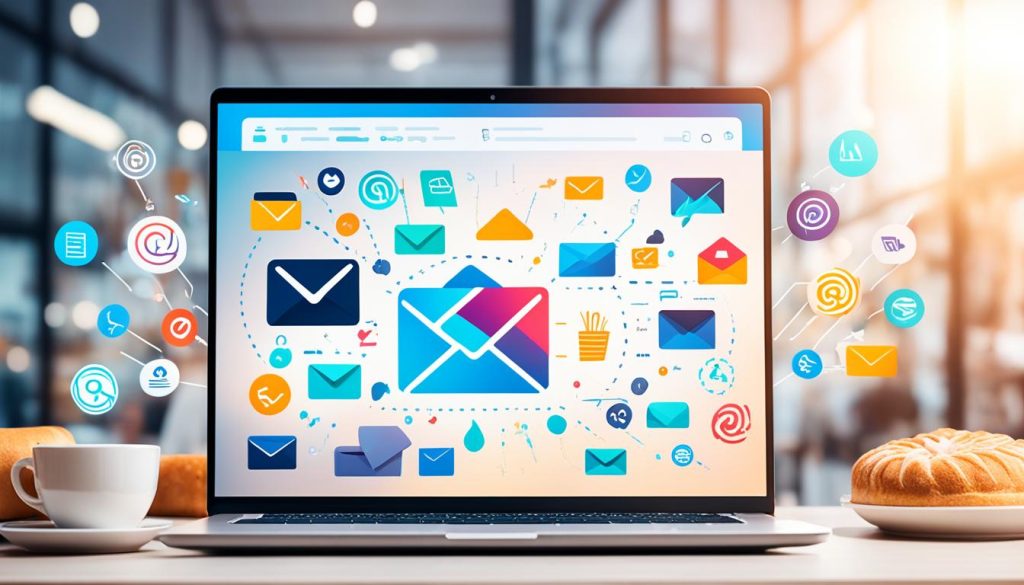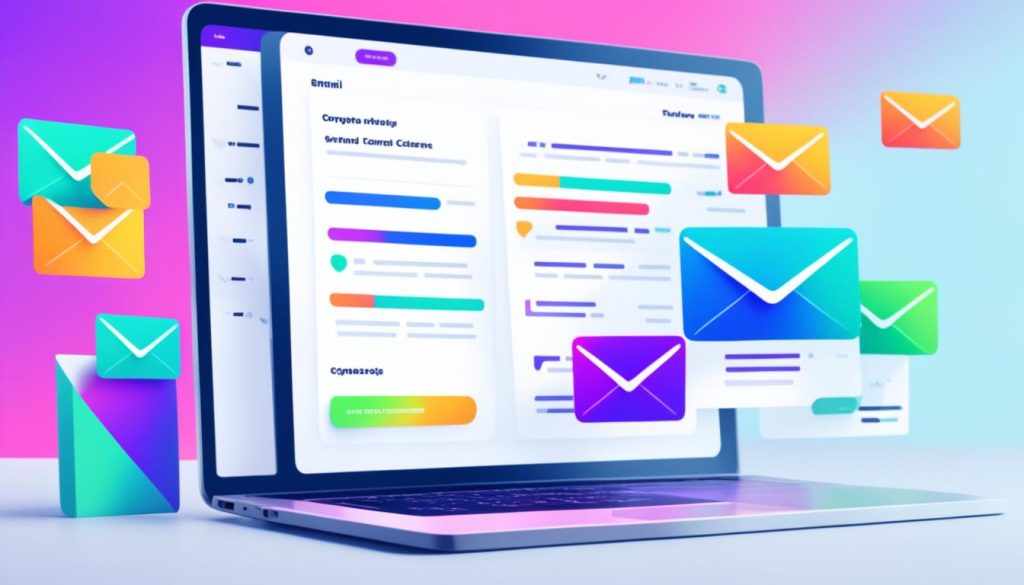Email marketing is now a key tool for businesses of all sizes to grow. This guide will cover the benefits of email marketing. It will also share strategies for building a strong email list, making engaging campaigns, automating your marketing, and tracking success. It’s useful for both small business owners and large marketing teams. This article will give you the insights and best practices to use email marketing effectively and boost your business.
Key Takeaways:
- Email marketing is a highly effective way to reach your target audience and drive business growth.
- Building a targeted email list is crucial for the success of your email marketing campaigns.
- Crafting compelling email content and subject lines can significantly improve engagement and conversions.
- Automation and segmentation can help you deliver personalized and relevant emails to your subscribers.
- Measuring key email marketing metrics is essential for tracking the success of your campaigns and making data-driven decisions.
The Power of Email Marketing
Email marketing is a strong tool for businesses to connect with customers and get real results. It has a high return on investment (ROI) and can target specific audiences. This makes email marketing key for any marketing plan.
Why Email Marketing Matters
Email marketing is a top digital marketing channel. It lets businesses talk directly to their customers. With email, companies can send personalized content that really speaks to their audience. This builds stronger relationships and boosts engagement.
Benefits of Email Marketing for Businesses
Email marketing brings real benefits to businesses. Some of the main advantages are:
- Improved Customer Engagement: Email campaigns help businesses connect with their audience in a personal way. This leads to more loyalty and keeping customers.
- Measurable Sales Growth: Good email marketing can really help sales grow. It often brings in more money than other digital marketing ways.
- Targeted Audience Reach: Email marketing lets businesses send content to specific groups of people. This means their messages hit home harder and get more attention.
- Cost-Effective Execution: Email marketing is cheaper than old-school marketing. It can bring in a big return on investment.
Using email marketing, businesses can build stronger customer ties, increase brand visibility, and grow their business. Email marketing is a proven and flexible digital strategy. It’s essential for any company wanting to boost its marketing and stay competitive.

Building a Targeted Email List
Creating a focused email list is key to a successful email marketing plan. By gathering a list of people who are truly interested, you can make your emails hit home. This leads to better results for your business.
Here are some top tips for building a targeted email list:
- Lead Magnets: Give away something valuable like an ebook or webinar for an email address. This draws in people who really want what you offer.
- Opt-in Forms: Put opt-in forms on your website, social media, and other places online. This makes it simple for people to sign up for your emails.
- Email Segmentation: Sort your email list by what people like, how they act, or who they are. This way, you can send them content that really speaks to them.
Remember, the secret to a great email list is giving your subscribers value. By focusing on email list building and email segmentation, you’ll build a group that looks forward to your emails.
“The money is in the list, but the fortune is in the relationship.” – Unknown

Keeping your email list clean and active is also key. Check your list often, remove people who don’t open your emails, and keep your info current. This makes sure your marketing hits the mark, making a bigger impact.
Crafting Compelling Email Campaigns
Creating engaging email campaigns is key to grabbing your audience’s attention and getting them to act. We’ll look at strategies to boost your email marketing and make a bigger impact.
Subject Line Strategies
The subject line is what makes people open your email. It’s vital. Here are some tips to make yours stand out:
- Keep it short and catchy, under 50 characters.
- Use the recipient’s name or other personal info to make it more relevant.
- Try different styles, like emojis, questions, or special offers.
- Test different subject lines to see what works best.
Email Content Best Practices
Your email’s content is its core. Here’s how to make it compelling:
- Make it personal by focusing on the recipient’s needs and interests.
- Add visuals like images, videos, or GIFs to make it more engaging.
- Write clear, concise copy that fits your brand’s style.
- Have a strong call-to-action to prompt the reader to act.
- Make sure your email looks good on mobile devices, as more people check emails on phones.
By improving your subject lines and email content, you can make your emails more personal and effective.

“The key to successful email marketing is to create content that your subscribers genuinely want to receive.”
Automating Your Email Marketing
Email automation is changing the game for businesses looking to make their work easier and improve customer experiences. By using email automation and email drip campaigns, you can make sure your subscribers get the right message at the right time. This makes their journey with your brand smooth and personal.
Welcome Emails and Onboarding Sequences
Your first email to new subscribers is very important. Automated welcome emails can introduce your brand, share useful info, and help new people get started. These emails help build trust, get people more involved, and prepare the ground for a strong partnership.
After the welcome, automated onboarding sequences can keep helping your subscribers. They can learn more about your products or services and be encouraged to move forward in their journey. With a series of automated emails, you can share relevant content, answer common questions, and build a stronger bond with your audience.
“Automating your email marketing can save you time, enhance the customer experience, and drive better results for your business.”
Using email automation and email drip campaigns helps you make your marketing work better. It ensures you communicate well and on time with your audience. This can lead to more customers and loyalty.
Segmenting Your Email List
Effective email marketing means sending messages that are both personal and relevant. To do this, segmenting your email list is key. By splitting your list into groups, you can send messages that fit each group’s needs and likes.
Tailoring Content for Different Audiences
Email segmentation helps you send messages that hit the mark. You can segment your list by:
- Demographic factors (e.g., age, gender, location)
- Behavioral data (e.g., website activity, purchase history, email engagement)
- Interests and preferences (e.g., product categories, content topics)
Knowing what each group likes and needs lets you send personalized emails. This means you can use subject lines and content that grab their attention. You can also send product suggestions or content that solves their problems.
“Email segmentation is the key to unlocking the true potential of your email marketing campaigns. By delivering content that is personalized and relevant to each subscriber, you can build stronger relationships and drive better results.”
Putting effort into segmenting your list and making targeted campaigns can really boost your results. Look for what works best for your business and your audience by trying different ways to segment.
Personalization: The Key to Engagement
Email marketing is changing fast, and personalization is now a key tool for better engagement. By making emails personal, businesses can connect more deeply with their audience. This leads to big benefits.
Email personalization greatly improves key email metrics. Personalized emails can increase open rates by up to 26% and clicks by 14%. Also, personalized product suggestions can boost conversion rates by 38%. These numbers show how powerful personalization is in email marketing.
To use personalization well, marketers use different strategies. Dynamic content changes based on what the recipient likes or does. Personalized product recommendations use the user’s past actions to suggest products. Triggered messages, like reminders about items left in the cart, show personalized care and help build loyalty.
| Personalization Tactic | Benefit | Impact |
|---|---|---|
| Dynamic Content | Tailored to individual preferences | Increased open and click-through rates |
| Personalized Product Recommendations | Driven by user behavior and purchase history | Higher conversion rates and revenue |
| Triggered Messages | Timely, relevant communication | Improved customer engagement and loyalty |
Using personalization can make email marketing better. It helps build stronger connections with the audience and leads to success. Investing in personalization is a smart way to improve email metrics and grow your brand.
Measuring Email Marketing Success
It’s key to track your email marketing success to improve your strategy and hit your business goals. By watching important email metrics, you learn how well your campaigns are doing. This helps you make smart choices to boost their impact.
Key Email Marketing Metrics
There are several important metrics to watch when measuring email marketing success:
- Open Rates: This shows how many people opened your email. It tells you if your subject lines and content work well.
- Click-Through Rates (CTR): The CTR shows how many people clicked on links in your email. It shows how engaged and interested they are in what you offer.
- Conversion Rates: This tracks how many people took a desired action, like buying something or filling out a form, after getting your email.
- List Growth: Keeping an eye on your email list’s growth is key. It shows how well your strategies to build your list work and how much people like your content.
Also, watch your email deliverability closely. Problems with deliverability can really hurt your campaign’s performance. Fixing these issues helps make sure your emails get to the right people, making your marketing more effective.
“Measuring the success of your email marketing efforts is essential for optimizing your strategy and achieving your business objectives.”
By always tracking these key metrics and fixing any deliverability issues, you get valuable insights into your campaigns. This helps you make smart changes to your email marketing strategy over time.
Email Marketing Best Practices
To make your email marketing successful, it’s key to follow best practices. Email marketing lets businesses connect with their audience and get clear results. By using proven strategies, you can make your email campaigns more effective and reach your goals.
Here are some important email marketing best practices to think about:
- Build a Targeted Email List: Spend time and effort on growing a quality email list. Focus on people who really want your products or services. Use lead magnets, opt-in forms, and other tactics to get the right audience.
- Create Compelling Content: Make email content that speaks to your audience. Use catchy subject lines, personalize your messages, and offer content that educates, entertains, or inspires your subscribers.
- Automate and Segment: Use email automation and segmentation to send the right message at the right time. Welcome emails, cart reminders, and targeted campaigns based on behavior can boost engagement and conversions.
- Measure and Optimize: Check your email marketing metrics often, like open rates, clicks, and conversions. Use these insights to improve your strategies, test new ideas, and make your campaigns better.
- Maintain Email Deliverability: Make sure your emails get to the inbox by following best practices for deliverability. Keep your list clean, avoid spam triggers, and follow industry rules.
By using these best practices in your email marketing, you can fully use this powerful tool. This will help you get meaningful results for your business.
| Best Practice | Description |
|---|---|
| List Building | Grow a targeted email list through lead magnets, opt-in forms, and other list-building tactics. |
| Content Creation | Craft compelling email content with attention-grabbing subject lines and personalized messages. |
| Automation and Segmentation | Leverage email automation and list segmentation to deliver personalized, targeted campaigns. |
| Metrics and Optimization | Analyze email marketing metrics and continuously refine your strategies for improved performance. |
| Deliverability | Maintain email deliverability by keeping your list clean and adhering to industry regulations. |
By following these email marketing best practices, you can fully use this powerful tool. This will help you get meaningful results for your business.
“Email is the most direct line of communication between a brand and its customers. By following best practices, businesses can leverage email to build stronger relationships and drive tangible results.” – Jane Doe, Email Marketing Strategist
Enhancing Email Deliverability
Getting your emails to the right inbox is key to your email marketing success. Email deliverability is vital for your campaigns to make an impact. By following best practices for list care, sender reputation, and email checks, you can boost your email deliverability. This leads to better results for your business.
Keeping your email list healthy is a big part of email deliverability. Clean your list by removing old subscribers, checking email addresses, and grouping your audience. This helps you avoid spam traps and keeps your sender reputation strong. Being proactive with your list can greatly improve your email metrics.
Managing your sender reputation is also key. Send emails that are valuable and on point, and steer clear of spam-like actions. This builds a good name with email services and boosts your chances of getting into inboxes.
Protocols like SPF, DKIM, and DMARC are crucial for email deliverability. They verify who you say you are and stop fake emails, which can hurt your delivery rates.
| Email Deliverability Best Practices | Benefits |
|---|---|
| Regular list hygiene and maintenance | Improved sender reputation and reduced risk of spam traps |
| Consistent delivery of valuable content | Enhanced engagement and trust with subscribers |
| Implementation of email authentication protocols | Strengthened sender identity and protection against spoofing |
Focus on these areas and use email deliverability tips in your marketing plan. This will help your messages get to the right inboxes and lead to success for your business.
Conclusion
As we wrap up our guide on email marketing, it’s clear this tool is key to your business’s success. We’ve covered building a targeted list, making compelling campaigns, automating your marketing, and measuring your success. These are the key parts that make email marketing a must-have for today’s businesses.
Using email marketing, email campaigns, and email automation lets you connect with your audience, build strong relationships, and get real results. Whether you’re into email list building, email newsletters, email drip campaigns, or email segmentation, this guide has given you the tools to boost your email marketing efforts.
Remember, making your emails more personal and tracking your email metrics is key. This way, you can make sure your messages get to the right people. Doing this will help you get the most out of your email marketing and bring in more customers for your business.
“Email marketing remains one of the most effective digital marketing strategies, delivering an average return on investment of $42 for every $1 spent.”
Email marketing is a continuous process of learning and improving. Stay flexible, keep up with changes, and always be looking to make your email marketing better. This will help you keep delivering value to your business and customers.
| Key Takeaways |
|---|
|
As you move forward, remember these key points and use email marketing to take your business to new heights. The path ahead may have its ups and downs, but with the right strategies and a commitment to getting better, you can unlock email marketing’s full potential. This will help your business grow and succeed.
Additional Resources
We’ve put together a list of great resources to help you improve your email marketing skills. You’ll find industry reports, expert blogs, online courses, and tools. These can keep you updated with the latest in email marketing. They’re perfect for both new and experienced email marketers.
Check out our selection of top blogs and courses on email list building and email newsletters. Learn how to make your email drip campaigns, email segmentation, and email personalization work better. Also, get tips on email metrics and email deliverability to make sure your emails get through.
With these resources, you’ll be ready to boost your email marketing game. Stay ahead in the fast-changing digital world. Use email to help your business grow and succeed.



